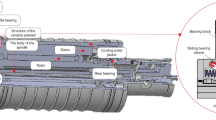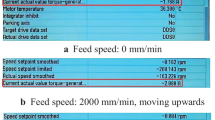Abstract
Thermal errors often occur in spindle system due to the changing of ambient temperature and/or inner or outer heat sources of machine tools (MTs), which is the major factor restricting the machine accuracy. Therefore, constructing compensation models with high accuracy and high robustness turn to be a cost-efficient approach for minimizing thermal error and improving machine accuracy. There are two categories of modeling methods for thermal errors so far, namely, physical-based method and empirical-based method. Each modeling method has its own merits and drawbacks. In this paper, a multi-objective genetic algorithm (MOGA) was used to combine the approximative physical model based on thermal expansion mechanism in vertical direction of numerical control (NC) lathe headstock with the accurate empirical model based on experimental data obtained from thermal performance test of spindle system. Consequently, a prediction model of thermal error in vertical direction of headstock with high accuracy and high robustness was obtained. The new model synthesized the advantages of the two types of modeling methods and showed relatively high accuracy and robustness. According to the results of a series of verification experiments on thermal performance of the spindle system under various ambient temperatures and different working conditions, the precision of prediction model has maintained above 74%.











Similar content being viewed by others
References
Bryan J (1990) International status of thermal error research. CIRP Ann 39(2):645–656. https://doi.org/10.1016/S0007-8506(07)63001-7
Mayr J, Jedrzejewski J, Uhlmann E, Alkan Donmez M, Knapp W, Härtig F, Wendt K, Moriwaki T, Shore P, Schmitt R, Brecher C, Würz T, Wegener K (2012) Thermal issues in machine tools. CIRP Ann 61(2):771–791. https://doi.org/10.1016/j.cirp.2012.05.008
Ni J (1997) CNC machine accuracy enhancement through real-time error compensation. J Manuf Sci Eng 119:717–725. https://doi.org/10.1115/1.2836815
Liu K, Li T, Wang Y, Sun M, Wu Y, Zhu T (2018) Physically based modeling method for comprehensive thermally induced errors of CNC machining centers. Int J Adv Manuf Technol 94(1–4):463–474. https://doi.org/10.1007/s00170-017-0736-9
Krulewich DA (1998) Temperature integration model and measurement point selection for thermally induced machine tool errors. MECHATRONICS 8(4):395–412. https://doi.org/10.1016/S0957-4158(97)00059-7
Zhao H, Yang J, Shen J (2007) Simulation of thermal behavior of a CNC machine tool spindle. Int J Mach Tools Manuf 47(6):1003–1010. https://doi.org/10.1016/j.ijmachtools.2006.06.018
Li Y, Zhao W, Wu W, Lu B (2017) Boundary conditions optimization of spindle thermal error analysis and thermal key points selection based on inverse heat conduction. Int J Adv Manuf Technol 90(9–12):2803–2812. https://doi.org/10.1007/s00170-016-9594-0
Tseng P (1997) A real-time thermal inaccuracy compensation method on a machining centre. Int J Adv Manuf Technol 13:182–190. https://doi.org/10.1007/bf01305870
Miao EM, Wang X, Fei YT, Yan Y (2011) Application of autoregressive distributed lag (ADL) model to thermal error modeling on NC machine tools. Appl Mech Mater 103:9–14. https://doi.org/10.4028/www.scientific.net/AMM.103.9
Chen JS, Chiou G (1995) Quick testing and modeling of thermally-induced errors of CNC machine tools. Int J Mach Tools Manuf 35(7):1063–1074. https://doi.org/10.1016/0890-6955(94)00101-O
Chen J (1996) A study of thermally induced machine tool errors in real cutting conditions. Int J Mach Tools Manuf 36(12):1401–1411. https://doi.org/10.1016/0890-6955(95)00096-8
Yang S, Yuan J, Ni J, More S (1996) The improvement of thermal error modeling and compensation on machine tools by CMAC neural network. Int J Mach Tools Manuf 36(4):527–537. https://doi.org/10.1016/0890-6955(95)00040-2
Mize CD, Ziegert JC (2000) Neural network thermal error compensation of a machining center. Precis Eng 24(4):338–346. https://doi.org/10.1016/S0141-6359(00)00044-1
Liang R, Ye W, Zhang HH, Yang Q (2012) The thermal error optimization models for CNC machine tools. Int J Adv Manuf Technol 63(9–12):1167–1176. https://doi.org/10.1007/s00170-012-3978-6
Wu H, Zhang H, Guo Q, Wang X, Yang J (2008) Thermal error optimization modeling and real-time compensation on a CNC turning center. J Mater Process Tech 207(1–3):172–179. https://doi.org/10.1016/j.jmatprotec.2007.12.067
Zhang Y, Yang J, Jiang H (2012) Machine tool thermal error modeling and prediction by grey neural network. Int J Adv Manuf Technol 59(9–12):1065–1072. https://doi.org/10.1007/s00170-011-3564-3
Ramesh R, Mannan MA, Poo AN (2002) Support vector machines model for classification of thermal error in machine tools. Int J Adv Manuf Technol 20(2):114–120. https://doi.org/10.1007/s001700200132
Hong Y, Ni J (2003) Dynamic modeling for machine tool thermal error compensation. J Manuf Sci Eng 125(2):245–254. https://doi.org/10.1115/1.1557296
Horejš O, Mareš M, Hornych J (2014) A general approach to thermal error modelling of machine tools. Machines et usinage a grande vitesse (MUGV), Clermont Ferrand, France
Brecher C, Shneor Y, Neus S, Bakarinow K, Fey M (2015) Thermal behavior of externally driven spindle: experimental study and modelling. Engineering 07(02):73–92. https://doi.org/10.4236/eng.2015.72007
Hou R, Yan Z, Du H, Chen T, Tao T, Mei X (2018) The application of multi-objective genetic algorithm in the modeling of thermal error of NC lathe. Procedia CIRP 67:332–337. https://doi.org/10.1016/j.procir.2017.12.222
Sun M, Yang Z, Li W, Liu Q, Guo J (2010) An improved thermal simulation model for the spindle of CNC machine tool. International Conference on Mechanic Automation and Control Engineering, 2010. IEEE, 187–190. https://doi.org/10.1109/MACE.2010.5535576
Yang S, Tao W (2006) Heat transfer theory (4ed.). Higher Education Press, Beijing
Incropera FP, DeWitt DP, Bergman TL (2014) Principles of heat and mass transfer. Wiley, New York
Vedder JD (1987) Simple approximations for the error function and its inverse. Am J Phys 55(8):762–763. https://doi.org/10.1119/1.15018
International standard ISO 230-3 (2007) Test code for machine tools - part 3: determination of thermal effects. (2ed.). Switzerland. https://www.iso.org/standard/39188.html
Wang L, Ng AHC, Kalyanmoy D (2011) Multi-objective evolutionary optimisation for product design and manufacturing. Springer, London. https://doi.org/10.1007/978-0-85729-652-8
Srinivas N, Deb K (1994) Multiobjective optimization using nondominated sorting in genetic algorithms. Evol Comput 2(3):221–248. https://doi.org/10.1162/evco.1994.2.3.221
Deb K, Pratap A, Agarwal S, Meyarivan T (2002) A fast and elitist multiobjective genetic algorithm: NSGA-II. IEEE Trans Evol Comput 6(2):182–197. https://doi.org/10.1109/4235.996017
Zio E, Bazzo R (2012) A comparison of methods for selecting preferred solutions in multiobjective decision making. In: C Kahraman (Ed.), Computational intelligence Systems in Industrial Engineering (6) 23–43. Atlantis Press. Paris. https://doi.org/10.2991/978-94-91216-77-0_2
Acknowledgements
The author would like to thank the anonymous referees and editors for their valuable comments and suggestions.
Funding
This project is supported by the National Natural Science Foundation of China (Grant No. 51775422).
Author information
Authors and Affiliations
Corresponding author
Additional information
Publisher’s note
Springer Nature remains neutral with regard to jurisdictional claims in published maps and institutional affiliations.
Rights and permissions
About this article
Cite this article
Hou, R., Du, H., Yan, Z. et al. The modeling method on thermal expansion of CNC lathe headstock in vertical direction based on MOGA. Int J Adv Manuf Technol 103, 3629–3641 (2019). https://doi.org/10.1007/s00170-019-03728-9
Received:
Accepted:
Published:
Issue Date:
DOI: https://doi.org/10.1007/s00170-019-03728-9




